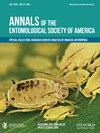外来Psyllides和外来寄主:北美非本土Psyllidea的积累(半翅目)
IF 3
3区 农林科学
Q1 ENTOMOLOGY
引用次数: 3
摘要
摘要木虱总科(半翅目)包括约4000种以树液为食的小型昆虫,称为木虱或跳跃植物虱。我们总结了北美非本地木虱动物群的物种组成,并回顾了检测记录、当前分布、宿主使用、生活史和地理来源。四十六种被认为是非本地物种,占已知北美木虱动物群的约10%。相对于全球木虱的多样性,木虱科在外来物种库中的比例过高(占外来物种的52%),而Triozidae(占外来品种的11%)的比例偏低。初步检测记录从1832年检测到一只欧洲梨木虱到2016年检测到来自亚洲的榕树专家。许多物种在北美表现出不连续的分布,可能是由于多次引入或已建立种群的二次传播造成的。非本地物种的寄主植物几乎完全是树木和灌木。与引进最相关的因素是木虱本地区宿主的存在。北美几乎所有的寄主植物都是有意进口用于人类相关用途的,最初的进口始于1500年代和1600年代。寄主植物在北美的到来通常比木虱的发现或到来早几十年或几个世纪。木虱几乎没有扩散到本地植物物种上,这反映了木虱总科宿主范围狭窄。一个明显的例外是,最近一种与木虱的欧洲Fraxinus宿主密切相关的本地Fraxinus的破坏性殖民化。与外来木虱的到来和建立相关的生物和地理特征随着时间的推移而发生了变化。温带欧洲是最早到达的物种的来源,最初的检测记录主要在新英格兰和加拿大东部。相比之下,最近到达的大多是来自新热带或澳大利亚的以杨梅科和蚕豆科为食的物种,检测记录主要局限于佛罗里达州或加利福尼亚州。早期到达的温带物种表现出正式的冬季滞育,而最近从新热带和澳大利亚到达的物种似乎或多或少地持续繁殖。本文章由计算机程序翻译,如有差异,请以英文原文为准。
Exotic Psyllids and Exotic Hosts: Accumulation of Nonnative Psylloidea in North America (Hemiptera)
Abstract The Psylloidea (Hemiptera) comprise ∼4,000 species of small sap-feeding insects known as psyllids or jumping plant-lice. We summarize species composition of the nonnative psyllid fauna in North America and review detection records, current distributions, host use, life histories, and geographical sources. Forty-six species are considered to be nonnative accounting for ∼10% of the known North American psyllid fauna. The family Psyllidae is overrepresented in the pool of exotics (52% of exotic species) relative to global psyllid diversity, whereas Triozidae (at 11% of exotic species) is underrepresented. Records of initial detection range from the 1832 detection of a European pear psyllid to the 2016 detection of a Ficus specialist from Asia. Many species exhibit discontinuous distributions in North America presumably caused by multiple introductions or by secondary spread of established populations. Host plants of nonnative species are almost exclusively trees and shrubs. The factor most correlated with introduction is presence of hosts from the psyllid's native region. Virtually all host plants in North America have been imported intentionally for human-related use, with initial importation beginning in the 1500s and 1600s. Arrival of host plants in North America often preceded psyllid detection or arrival by decades or centuries. There has been almost no spillover by psyllids onto native plant species reflecting the narrow host range of Psylloidea. A glaring exception is the recent damaging colonization of a native Fraxinus closely related to the psyllid's European Fraxinus host. Biological and geographical traits correlated with arrival and establishment of nonnative psyllids have shifted through time. Temperate Europe was the source of the earliest arriving species, with initial detection records primarily in New England and eastern Canada. In contrast, recent arrivals are mostly Myrtaceae- and Fabaceae-feeding species from the Neotropics or Australia, with detection records limited mostly to Florida or California. Early-arriving, temperate zone species exhibit a formal winter diapause while recent arrivals from the Neotropics and Australia appear to reproduce more-or-less continuously.
求助全文
通过发布文献求助,成功后即可免费获取论文全文。
去求助
来源期刊
CiteScore
4.90
自引率
0.00%
发文量
25
审稿时长
6-12 weeks
期刊介绍:
The Annals of the Entomological Society of America exists to stimulate interdisciplinary dialogue across the entomological disciplines and to advance cooperative interaction among diverse groups of entomologists. It seeks to attract and publish cutting-edge research, reviews, collections of articles on a common topic of broad interest, and discussion of topics with national or international importance. We especially welcome articles covering developing areas of research, controversial issues or debate, and topics of importance to society. Manuscripts that are primarily reports of new species, methodology, pest management, or the biology of single species generally will be referred to other journals of the ESA. The most important criteria for acceptance are quality of work and breadth of interest to the readership.

 求助内容:
求助内容: 应助结果提醒方式:
应助结果提醒方式:


